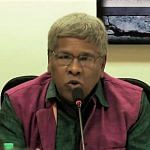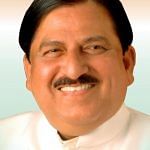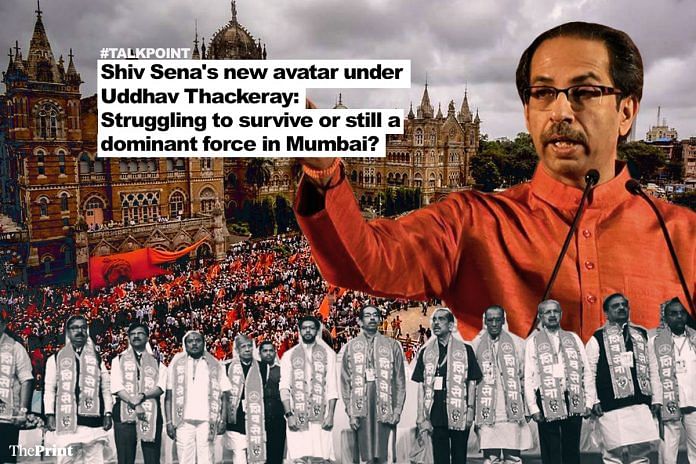On 19 June 1966, Bal Keshav Thackeray founded the Shiv Sena. He branded it as a party that would fight for Mumbai’s Marathi population and ensure that the fruits of the city’s economic growth go to the locals. It laid the foundation for the nativist ‘sons of the soil’ politics and went on to rule Mumbai’s civic body for more than two decades. As the party turns 52 today,
ThePrint asks: Shiv Sena’s new avatar under Uddhav Thackeray – struggling to survive or still a dominant force in Mumbai?
Only Uddhav Thackeray, Shiv Sena can halt Modi wave
 Manisha Kayande
Manisha Kayande
Shiv Sena spokesperson
The Shiv Sena has been one of the most popular parties in Mumbai and Maharashtra. As we celebrate our foundation day, we can see that our party’s base has increased manifold and is strengthening by the day. This is because people see the Shiv Sena as the most dependable party and find our workers and leaders easily accessible – whether at the level of shakhas (branches), or MPs and MLAs.
Not just accessible, our elected representatives are also performance-oriented. They don’t sit silent in the legislature or Parliament. They speak up even if it means they have to fight with their own government.
Uddhavji’s administrative skills are highly admired by everybody. He takes a strong stance on most issues and is looked up to as a genuine leader. He does not mince his words irrespective of who he is dealing with, be it the coalition partner, the chief minister, or the leaders at the Centre. His first priority is always the well-being of the public and the party and doesn’t let the Shiv Sena be dragged behind the BJP everywhere.
Aaditya Thackeray too has become a youth icon and takes up relevant issues, such as environment and sports, which strike a chord with everyone.
The BJP did come very close to the Shiv Sena’s tally in 2017 Mumbai civic body elections, but that is largely because the 2014 Modi wave had persisted. In 2018, we are seeing a sudden change where the BJP is losing popularity. Only Uddhav Thackeray and the Shiv Sena can halt the Modi wave.
Mumbai’s demography has changed, and the number of Marathi voters has dwindled over the years. The BJP won largely because of the Gujarati and Marwari voters in the city.
But ultimately, everybody knows that among regional parties, the Shiv Sena is the most popular and result-oriented. We too have become more flexible with the changing demography over the years. Although in smaller numbers, there are a lot of non-Marathi leaders in the Shiv Sena now.
Maharashtra’s dwindling Marathi population has compelled Shiv Sena to change too
 Datta Iswalkar
Datta Iswalkar
Leader of Mumbai’s erstwhile mill workers
After Mumbai’s mills had shut down, the workers residing in the city’s central and southern areas dispersed. While the mill workers were originally aligned with leftist parties, their second generation were largely Shiv Sena followers, who were attracted to the party by its ‘sons of the soil’ politics.
Shiv Sena’s main agenda in Mumbai was to work for the Marathi people, but that population has dwindled in the city now. As a result, the party has not been talking much about the Marathi people and has instead chosen to stick to the larger Hindutva agenda.
However, one cannot deny the fact that Mumbai’s Marathi belt, or central Mumbai, still largely votes for the Shiv Sena. Although the party has not done anything tangible to protect the city’s Marathi people, other parties have not specifically addressed the Marathi issue either. So, out of sheer habit and lack of alternative, the votes have still been going to the Shiv Sena.
Even when the Modi wave hit and pushed the Congress out, changing the political landscape of Maharashtra, the Marathi voters from Mumbai continued to opt for the Shiv Sena. What the BJP won were the non-Marathi votes in the city.
The Shiv Sena is now visibly trying to take a more inclusive stand in Mumbai. It has no option but to do so if it wants to perform well electorally and retain its hold over the Brihanmumbai Municipal Corporation (BMC).
Considering the city’s demography has changed and the Marathi population stands at just 38 per cent, the Shiv Sena is compelled to change too.
Despite Shiv Sena controlling BMC for 25 years, BJP has done more for Mumbai
 Atul Bhatkhalkar
Atul Bhatkhalkar
BJP MLA
The BJP and the Shiv Sena are the dominant forces in Mumbai now. The Shiv Sena used to enjoy political clout, but over the past few years its significance has been reduced to a great extent. Their confused political position is to blame for this. At one level, they talk about the ‘sons of the soil’, and at another level, they talk about Hindutva. A few years ago, they even started a ‘Mi Mumbaikar’ (I am a Mumbaikar) campaign. This has left voters confused.
It is a Catch-22 situation for the Shiv Sena. They are trying to get votes from the non-Marathi people in the city, and in the bargain losing their Marathi voters. The talk of ‘Marathi asmita’ is not enough to persuade voters anymore.
On the ground, the Shiv Sena has done nothing for Mumbai’s Marathi population. A few years ago, there was a provision for a ‘Marathi Bhavan’ in the city’s annual budget but not a single penny has been spent on that idea until now. Non-Marathi voters too are not happy with the Shiv Sena’s rule over the BMC.
The Shiv Sena has controlled the BMC for the last 25 years, but there are no tangible changes that Mumbai’s citizens can see in their lives, and that is the Shiv Sena’s greatest failure.
On the other hand, despite the Mumbai civic corporation not being in our hands, the BJP is giving people what the Shiv Sena has not been able to give –infrastructure development. Over the past three-and-a-half years that the BJP has been ruling the state, we have commenced work on the new airport, the trans-harbour link, and several Metro lines. Work on the Bandra-Versova sea link too will begin this year. We have given a special status to the state housing board as a planning authority for faster redevelopment of old buildings in the city.
Shiv Sena has gone from politics of hate to politics of survival
 Surendra Jondhale
Surendra Jondhale
Political analyst
The Shiv Sena’s birth was primarily meant to protect the existence of the ‘Marathi manus’ in Mumbai. The party was Mumbai’s Marathi face, with support from the city’s lower middle class, middle class, chawl dwellers and mill workers. At that time, Mumbai had a modern and cosmopolitan face, which the Shiv Sena consciously tried to change to a more parochial one.
Though Mumbai is the Shiv Sena’s birthplace, it has not done anything concrete for the city. The Shiv Sena has not helped with the rehabilitation of Mumbai’s textile mill workers. The city’s infrastructure is still a problem, and the party has not worked towards a cohesive plan for Mumbai’s development. Central Mumbai’s Marathi-dominated pockets like Dadar, Parel, Lalbaug were its bastions, but it is alleged that the Sena allowed their landscape to become more corporatised with high-rises and wealthy non-Maharashtrian families pushing out the middle-class Marathi population to the city’s fringes.
The Shiv Sena also has an organisational dilemma as there is no one clear section of supporters for the party in Mumbai today. Earlier, the middle classes and lower middle classes were its supporters, but they have undergone a social and economic transformation. The party is surviving now largely because of a notional attachment with voters who think that the Shiv Sena should be there in Mumbai to keep the outsiders in check.
The Shiv Sena today is going through an identity crisis. It is a coalition partner of the government, but neither can it drive governance nor can it take credit for the state government’s policies. The party is also confused about its approach – whether it should stress on the politics of Hindutva, or the politics of development, or the politics of language and culture of the ‘Marathi manus’.
Earlier, the party was very much involved in the politics of hate, taking stances that were anti-Muslim, anti-Tamil, and that helped in its existence. But now, due to the changed political discourse, it has to play the politics of survival.
Shiv Sena is trying to stress its ‘Marathi’ agenda in Mumbai
 Madhu Chavan
Madhu Chavan
Former Congress MLA
There is a difference between Balasaheb’s Shiv Sena and Uddhavji’s Shiv Sena. But despite that, even today, the Shiv Sena has a strong hold on Mumbai’s Marathi population. The party still works for them and so the Marathi population continues to vote for the Sena.
Both the Congress and the Shiv Sena work for the people in Mumbai but there are stark differences in the way they do it. The Congress works on a secular footing, without looking at caste, language or religion of a person, while the Shiv Sena works on a more parochial and Hindutva agenda.
We cannot say that any one party has dominance over Mumbai. We accept that the Shiv Sena has been ahead of the Congress in this city, but there have been times when the Congress has overtaken the Shiv Sena. In 1992, for instance, we wrested control of the BMC from the Shiv Sena and showed that we can work well. In the 2009 assembly election, the Congress won 17 of the 36 constituencies in Mumbai.
Both the Congress and the Shiv Sena work in Mumbai and, therefore, they are popular among the voters.
Of late, we can see that the Shiv Sena is trying to stress its ‘Marathi’ agenda in Mumbai. Members of the Shiv Sena allegedly burnt copies of Mumbai’s development plan printed in English.
Going forward, Aaditya Thackeray seems to be a promising leader for the Shiv Sena. Like Balasaheb shaped Uddhavji and Raj Thackeray, Uddhavji seems to be shaping and promoting Aaditya. The leader is still young, but has made some good points regarding his vision for the city. If he can deliver on these points, voters may accept him.
Party that fuelled ‘sons of the soil’ theory is now putting up Gujarati banners
 Manasi Phadke
Manasi Phadke
Associate Editor, ThePrint
The Shiv Sena gauged its current electoral strength on its home turf, Mumbai, only after it split with the BJP and contested two elections independently. The results were less than flattering, and showed that while the party remains the dominant force in Mumbai’s political landscape, the city is not exclusively its citadel anymore.
In the two recent elections it contested solo, the party could retain most Marathi votes in Mumbai. But, despite having adopted a broader Hindutva agenda, it could not keep the city’s non-Marathi votes, which would earlier go to the Sena-BJP combine, from going into the BJP’s kitty.
Uddhav Thackeray’s emotive appeal of “Sena belongs to Mumbai and Mumbai to Sena” months before the 2017 Mumbai civic body elections kept its traditional Marathi voters intact, but failed to cut ice with younger Maharashtrians. For them, roads, traffic and housing mattered more and the BJP’s glittering brochures, which promised them these things, were more attractive.
In the course of these two elections, the party has realised that it needs to wear a more inclusive garb and force a change in the voters’ mindset that links the Shiv Sena with parochialism. The efforts are visible. A party that was once known for fuelling the Marathi versus Gujarati debate and attacking non-Maharashtrians now has its leaders putting up hoardings in Gujarati and organising Chhath pujas.
Once blamed for orchestrating the 1993 riots against Muslims, the party now has a Muslim corporator in the civic body. The Shiv Sena is consciously promoting Thackeray scion Aaditya Thackeray as the younger, softer face of the Shiv Sena, who is talking about football, open spaces, night life and the environment.
Its campaign tagline for the 2017 civic polls ‘#DidYouKnow’ was in English to reach a wider audience. We are, however, yet to see the electoral impact of these measures.
There was a time when the Shiv Sena, especially its founder Bal Thackeray, could bring Mumbai to a standstill as was seen after senior Thackeray’s death. Some would fall in line out of loyalty, and others out of fear. Does that still hold true? We may not know because in its new avatar, the Shiv Sena seems to have visibly moved away from that kind of politics.
Compiled by Manasi Phadke, Associate Editor at ThePrint.




SS should keep a strong control over mumbai or its going to be a second bihar under the BJP.lots of migrants are arriving daily with false adaar card N voting for BJP
And the charm of maharashtra is loosing day by day
So SS party stay awake and work for mumbaikars no matter marathi or muslims
We r one